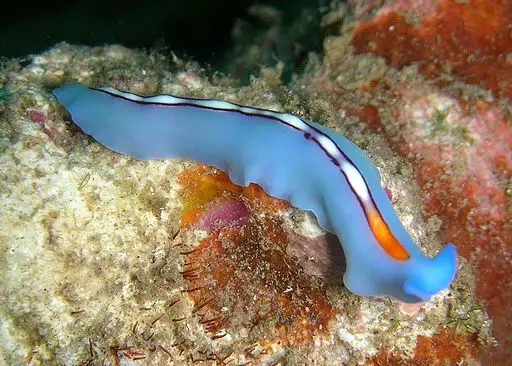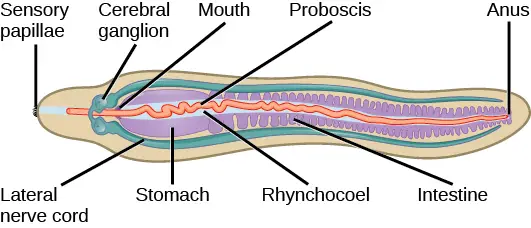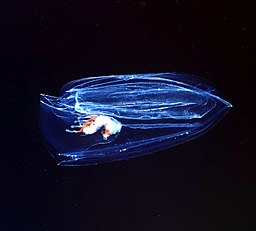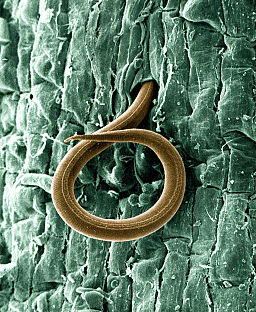Acoelomata
** Definition, Examples, Vs Pseudocoelomate
Definition
Essentially, Acoelomata is a subdivision (or super-phylum) that consists of animals without a true body cavity. Also known as a coelom, the body cavity is a fluid-filled space located between the body wall and the digestive tract.
Some of the best examples of body cavities in human beings are the ventral (where the heart, lungs, and intestines, etc. are located) and dorsal cavities (where the brain and spinal cord are located). In acoelomates, the space between the body wall and gut usually consists of mesenchyme (or some muscle fibers) rather than coelomic fluid (the fluid that separates and protects various organs).
* Generally, acoelomates are characterized by a triploblastic body organization consisting of the ectoderm, mesoderm, and endoderm. For this reason, some simple animals like sponges, members of the phylum Porifera, are not considered true acoelomates despite not having a coelom - Acoelomata.
Acoelomata Examples
Some examples of animals within the group Acoelomata can be found within several phyla that include:
Platyhelminthes
The phylum Platyhelminthes consists of dorsoventrally flattened worms known as flatworms. Despite variations in their size and some aspects of their morphology, members of this group share a number of important characteristics including a dorsoventrally flattened body, bilateral symmetry, cephalization, and tissues derived from three germ layers (triploblastic).
Like other members of acoelomates, flatworms do not have a body cavity (coelom). Instead of a fluid, the space between the body wall and internal organs is separated by a mesenchymal tissue (mesodermal tissue) commonly known as parenchyma. In turbellarians, a class of the phylum Platyhelminthes, the tissue consists of various cells and the extracellular matrix.
Some of the cell types found in this region include stem cells (pluripotent cells known as neoblasts), true parenchymal cells (E.g. ramified cells, granule filled cells, and fixed parenchymal cells), and bodies of epithelial cells (E.g. cells of the digestive system etc.).
In addition to the parenchyma, this space also consists of musculature (e.g. dorsoventral and transverse muscles).
Some functions of the parenchyma include:
· It's a substrate that supports the organization and functions of the epithelial layers
· Because it contains a group of stem cells, it's involved in the development and regeneration
· Nutrient storage
· Regulating the concentration of intracellular ions between the cells of the parenchyma and other types of cells (those connected to gap junctions)
* The extracellular matrix is absent in the parenchyma of some Platyhelminthes (e.g. Acoella, Catenunulida, and Nemertodermatida).
Some examples of Platyhelminthes include:
· Taenia saginata
· Paragonimus westermini
· Schistosoma japonicum
· Fasciola hepatica
· Clonorchis sinensis
Phylum Nemertea (Rhynchocoela or Nemertinea)
Also known as ribbon worms, the majority of ribbon worms are marine organisms characterized by a long, thin body (some species like Lineus longissimus can grow to be 30 meters long). Like members of the phylum Platyhelminthes, these worms are bilaterally symmetrical, dorsoventrally flattened animals.
They are also described as triploblastic animals with tissues originating from three germ layers. Though the phylum Nemertea is generally considered to be acoelomate, some researchers have suggested that the proboscis cavity qualifies as a true coelom (rhynchocoel).
While ribbon worms have some type of body cavity, the interior of the body wall, between the body wall and gut, is coated with a mesenchyme (parenchyma) which consists of a gel matrix and dorsoventrally oriented musculature.
The thickness of the mesenchyme varies between different species (average 15um). In addition to protecting the internal body organs, the mesenchyme is also involved in the maintenance and development of the gonads.
Some examples of species in this group include:
· Lineus longissimus
· Argonemertes species
· Carcinonmetes errans
· Paranemertes peregrina
Phylum Gnathostomulida
The phylum Gnathostomulida consists of about 100 known species, most of which are marine animals. Compared to many other worms, most Gnathostomulids are tiny organisms (thread-shaped) ranging from 0.3mm to 3.6mm in length.
With the exception of a few species, Gnathostomulids are characterized by a transparent/colorless, ciliated body (they are monociliated with each epidermal cell carrying a single cilium). Like Platyhelminthes and members of the phylum Nemertea, Gnathostomulids are bilaterally symmetrical with more than two cell layers . They are commonly described as being low triploblasts.
Like other acoelmates, Gnathostomulids do not have a body cavity. However, they also lack a parenchyma which is commonly found in some of the other acoelomate worms. This is replaced by a weakly developed, cross-striated musculature and filler cells between the body wall/epidermis and the gut.
* In some literature, the spaces between internal organs are suggested to consist of loose mesenchyme.
Generally, the musculature consists of circular and diagonal muscles in addition to bundles of longitudinal muscles. These muscles extend the entire length of the body. The superimposition of all these muscles results in a dense grid-like musculature.
Some of the functions of the musculature in these organisms include:
· Structural support
· Burrowing (Through the peristaltic movement of rostrum muscles)
· Support functions of the pharynx and jaw apparatus
Some examples of species in this group include:
· Haplognathia simplex
· Gnathostomula armata
· Problognathia minima
· Gnathostomula paradoxa
Some examples of diploblastic organisms that lack a body cavity/coelom include:
Phylum Porifera
The phylum Porifera consists of multicellular organisms (sponges) with few tissues and no organs. They greatly vary in size, shape, and complexity. Compared to some of the other acoelomates, sponges are diploblastic and only consist of the ectoderm (which makes up the outer body later) and the endoderm (makes up the inner layers).
These two layers are separated by the mesenchyme. In sponges, this layer is commonly known as the mesohyl. It's an acellular layer of gelatinous matrix that contains spicules (calcium carbonate structures) and/or spongin (a protein) which provide structural support.
* In sponges, the mesenchyme serves as an endoskeleton. As such, it plays an important role in maintaining the shape of the organism.
* While the mesohyl is an acellular matrix (collagen-like gel), it contains a few suspended cells (archaeocytes) which are involved in a number of functions such as reproduction.
Some examples of species within the phylum Porifera include:
· Aplysina cauliformis
· Agelas clathrodes
· Aiolochroia crassa
· Callyspongia fallax
· Ectyoplasia ferox
Phylum Coelenterata
Also known as Cnidarians, members of the phylum Coelenterata are mostly marine organisms. Some species can be found in freshwater environments. While some individuals are free swimmers, others can be found at the bottom of the sea attached to various substrates. However, they are also characterized by radial symmetry and a tissue level of organization.
Like members of the phylum Porifera, Cnidarians are diploblastic. As such, their bodies are made up of two germ layers; the ectoderm which makes up the outer layer, and the endoderm which makes up the inner tissue layers. As acoelomate animals, they lack a body cavity/coelom.
Instead, the space between the two layers (inner and outer layer) contains a jelly-like layer known as the mesoglea. The layer exhibits different characteristics depending on the type of Cnidarian.
For instance, whereas the mesoglea is generally simple and acellular in Hydrozoa species (however, cell bodies can extend into the matrix), it's cellular in Scyphozoa and Anthozoa species. In Anthozoans, it may also contain fibrous connective tissue.
* In Hydra, most common Cnidarians, the mesoglea consists of a number of components including the basal laminae, fibrils, and cell bodies.
* In Cnidarians, the mesoglea acts like a hydrostatic skeleton.
Some examples of species within the phylum Coelenterata include:
· Rhopilema esculentum
· Elagia noctiluca
· Pleurobrachia pileus
· Chrysaora melanaster
Phylum Ctenophora
The phylum Ctenophora consists of sea walnuts and comb jellies. The majority of species in this group are free-swimming animals found in marine habitats (from the water surface to a depth of about 3,000 meters).
There are over 200 species in this group that exhibit a wide variation in shape, ranging from pear-shaped to cylindrical and ribbon-shaped. The majority of species are biradially symmetrical with elongated tentacles. Like some of the other acoelomates, Ctenophora species are diploblastic organisms with two cell layers and a thick cellular layer (mesoglea).
In some literature, the mesoglea is considered a third layer that qualifies Ctenophra species as triploblastic organisms. Compared to the mesoglea found in Cnidarians, mesoglea/collenchyma contains elastic fibers, muscle cells, and amoebocytes which sets it apart.
* In Ctenophora species, the mesoglea provides structural support and thus serves as an internal skeleton.
Some examples of species within the phylum Ctenophora:
· Pleurobrachia pileus
· Eurhamphaea vexilligera
· Tjalfiella tristoma
· Lampea pancerina
Pseudocoelomates
Members of the subdivision pseudocoelomata are characterized by a space, a fluid-filled cavity, between the body wall and the gut. This space is known as a pseudocoel and not a coelom. As such, it's known as a false coelom because it's not lined by mesodermal epithelial cells (peritoneum) commonly found in coelomates.
Therefore, one of the biggest differences between acoelomates and pseudoacoelomates is that while pseudocoelomates have a false body cavity, acoelomates do not have any cavity.
* Because the peritoneum is lacking in pseudoacoelomates, most of the internal organs are free within the cavity.
* The false coelom (pseudocoelom) in pseudocoelomates is located between the endoderm and the mesoderm.
Some of the most common pseudocoelomates belong to four main groups that include:
Phylum Acanthocephala
The phylum Acanthocephala consists of over 1,300 species collectively known as spiny-headed worms. As adults, they are exclusively found in the small intestine of vertebrates (marine and freshwater vertebrates) where they live as parasites.
Like most worms, Acanthocephalans are bilaterally symmetrical with a body plan that can be divided into several regions.
* In Acanthocephalans, the pseudocoelom functions as a lubricant between some of the organs. In addition, it's involved in the transportation of nutrients and other material.
Some members of the phylum Acanthocephala include:
· Neoechinorhynchusschmidti
· Pseudocorynosoma anatarium
· Pseudoleptorhynchoides lamothei
· Oncicola luehei
Phylum Entoprocta (kamptozoans)
The phylum Entoprocta consists of about 200 species known as entoprocts. The majority of species are found in the marine environment where they are attached to substrata (shells, seaweed, etc.). Generally, they are characterized by a cup-like calyx (crown) with ciliated tentacles and a relatively long stalk that connects the crown to the muscular foot. As such, they may be mistaken for Cnidarians.
Entoprocts are generally small in size, ranging from 0.4 to 5 mm in height and have a number of important organs/tissue including a mouth, intestine, and rectum, etc.
* While members of this phylum are generally described as being pseudoacoelomates, they are described as acoelomates in some literature.
Some of the species found in this group include:
· Loxosomatoides sirindhorne
· Urnatella gracilis
· Pedicellina species
Phylum Rotifera
The phylum Rotifera is a large group that consists of more than 2,200 known species. While the majority of species can be found in freshwater, they can also be found in marine and terrestrial habitats.
They are characterized by three main body parts including the head, trunk, and foot. However, morphology varies between different species. They are also very small in size, ranging from 40 to 2000 um in length. For this reason, they are often confused for some protists. Regardless, they are multicellular, triploblastic organisms.
While they have a fluid-filled body cavity that separates the body wall from the gut, it's only lined by a mesoderm on the body wall side. They are considered pseudoacoelomates because this cavity is not lined by mesoderm and endoderm on both sides.
* Rotifers are generally considered to be pseudcoelomates. However, based on new findings, they have been shown to be closely related to coelomates than other pseudocoelomates.
Some members of the phylum Rotifera include:
· Rotaria neptunia
· Epiphanes brachionus
· Brachonius calyciflorus
Phylum Nematoda
The phylum Nematoda consists of over 20,000 species that can be found in both aquatic and terrestrial habitats throughout the world as parasites or as free-living organisms. Also known as roundworms, nematodes are elongated, cylindrical animals with bilateral symmetry and tapered ends.
Like many other animals, Nematodes are triploblastic and thus have three germ layers. Compared to some of the other worms, some roundworms can be relatively long and can grow to over 7 meters in length.
As pseudocoelomates, roundworms do not have a true coelom. Rather, the body cavity consists of pseudocoel/blastocoel that may contain parenchyma in some cases. Unlike true coelom, this fluid is not lined/covered by a mesoderm. In roundworms, the pseudocoelom contributes to their general cylindrical shape.
The tough cuticle covering the surface of the organism has been shown to prevent the body from expanding. As such, it also allows fluid pressure to build up in the pseudocoelom which in turn acts as a hydrostatic skeleton. This is particularly important because the pseudocoelom provides the counterforce required for muscle contraction during movement.
Some members of the phylum Nematoda include:
· Ascaris species
· Necator species
· Enterobius species
· Trichinella species
See also:
Coelomates, Acoelomates and Pseudocoelomates
Return from Acoelomata to MicroscopeMaster home
References
Carolina Noreña, Cristina Damborenea and Francisco Brusa. (2015). Phylum Platyhelminthes.
Malin Strand, Alfonso Herrera-Bachiller, Arne Nygren, and Tobias Kanneby. (2013). A new nemertean species: what are the usefulcharacters for ribbon worm descriptions?
Rich Mooi. et al. (2007). Animals of San Francisco Bay: a field guide to its common benthic species.
Wolfgang Sterrer and Martin V. Sørensen. (2014). Phylum Gnathostomulida.
Links
https://www.researchgate.net/publication/282249906_Platyhelminthes
https://animaldiversity.org/accounts/Ctenophora/
Find out how to advertise on MicroscopeMaster!









